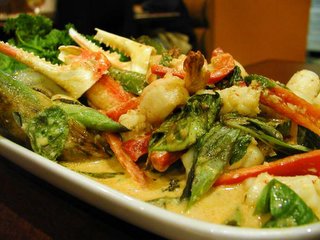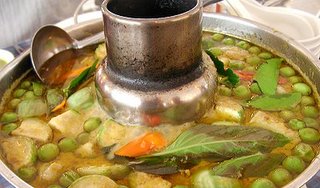Why Thai Food is so good

"Thai food offers a variety of flavours and tastes. The subtle mixing of herbs and spices and market-fresh ingredients makes dining a special culinary experience."
Eating ranks high on the Thai scale of pleasures, and meals are informal affairs. The staple is rice, either ordinary or glutinous, accompanied by a variety of dishes that can be eaten in almost any order, and seasoned to individual taste with several condiments such as fish sauce and chilli peppers. Most often there will be a soup of some kind, a curry, a steamed or fried dish, a salad, and one or more basic sauces. Desserts may consist of fresh fruit or one of the many traditional Thai sweets.
Much of what is known about Thai cuisine evolved in the central region of the country. Rice, fish, and vegetables, flavoured with garlic, black pepper, and nam pla (fish sauce), along with an abundance of fresh fruit, comprised the basic diet of Sukhothai. With the rise of
A century ago, meals were eaten by hand, pressing the rice into the little balls; today a spoon and fork are used for eating rice, while chopsticks are used for Chinese-type noodles.
The different territories
Thai food differs from region to region. Unlike the North and Northeast, where glutinous rice is popular, Central Thais like the fragrant plain variety, most commonly steamed. In addition to fresh-water fish, there is seafood from theThe Central region also has what is called the Royal cuisine, a more sophisticated version of the regional cuisine. Influenced by the kitchens of the
A favourite regional speciality is a spicy pork sausage called naem. The traditional form of meal is called a Kantoke dinner during which diners sit around a small low table. Nightly gala performances of a royal version of the Kantoke banquet can be enjoyed at reconstructed wooden palaces. These performances include troupes of local dancers, resplendent in traditional costume and can be pre-booked at this link.
Northeastern food reflects the influences of neighbouring
In the South, the coconut plays a prominent role in many dishes; its milk tempers the heat of chilli-laced soups and curries, its oil used for frying, and its grated meat serves as a condiment. Fresh seafood from the surrounding waters is abundant: fish, prawns, lobsters, crab, squid, scallops, calms and mussels. Cashew nuts from local plantations are eaten as appetisers or stir-fried with chicken and dried chillies, while a pungent flat bean called sator adds an exotic, if somewhat bitter, flavour much admired by southern diners. Chinese-Thai food is popular in large cities as well. Other foreign influences can be found in such dishes as kaeng matsaman, a mild Indian-style curry seasoned with cardamon, cloves and cinnamon, and sate - skewered meat with a spicy peanut sauce that originally came from
With Thai cuisine enjoying an outstanding world-wide reputation for its unique flavours and tastes, there's no better way to learn about this cooking style than in
Other Eating Possibilities in the North.
I have met folk who actually didn't like rice and although it was tempting to send him back home immediately with a "you're in the wrong country" retort if didn't cause much of a problem at all. I realise that not everyone loves the mouth-watering hot dishes that typify Thai cuisine. The main cities all boast of a number of excellent Chinese and Western restaurants. Chiang Mai is the centre with an astonishing number international first class dining areas. Hawkers stalls abound and the city has ample representations of English, Irish, French, German, Swiss, Spanish, American, Korean, Japanese outlets as well, of course, as most of the regular fast food franchises. Not easy to be hungry in such a diners paradise. Pubs are also easily found and there is a great variety of small road-side beer stalls to fully-fledged disco's.
The best deal in the country has to be the daily buffet lunches held at the major hotels. For as little as $2.50 diners can experience local and international delicacies until their hearts content or belly full.
Chiang Mai has an annual food festival in November where the city's best chef's compete in friendly rivalry at presenting the best cuisine both Thai and international.

0 comments:
Post a Comment